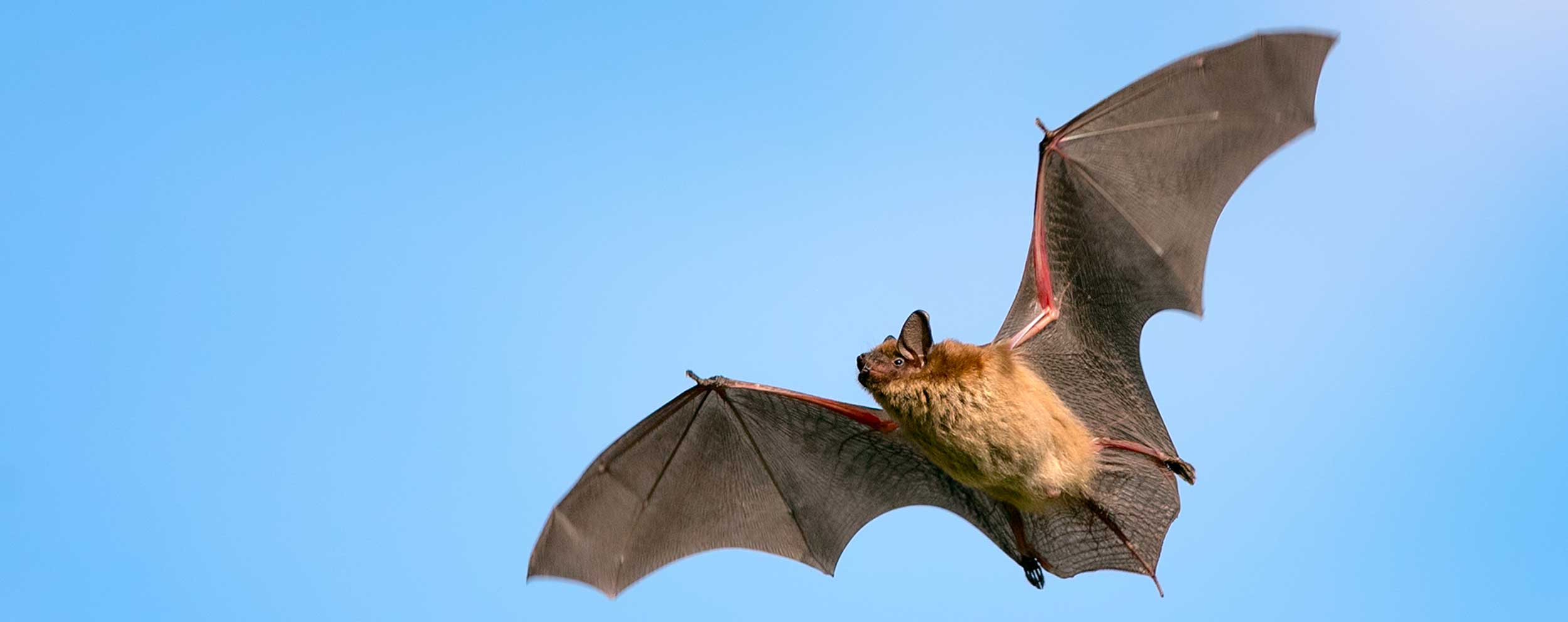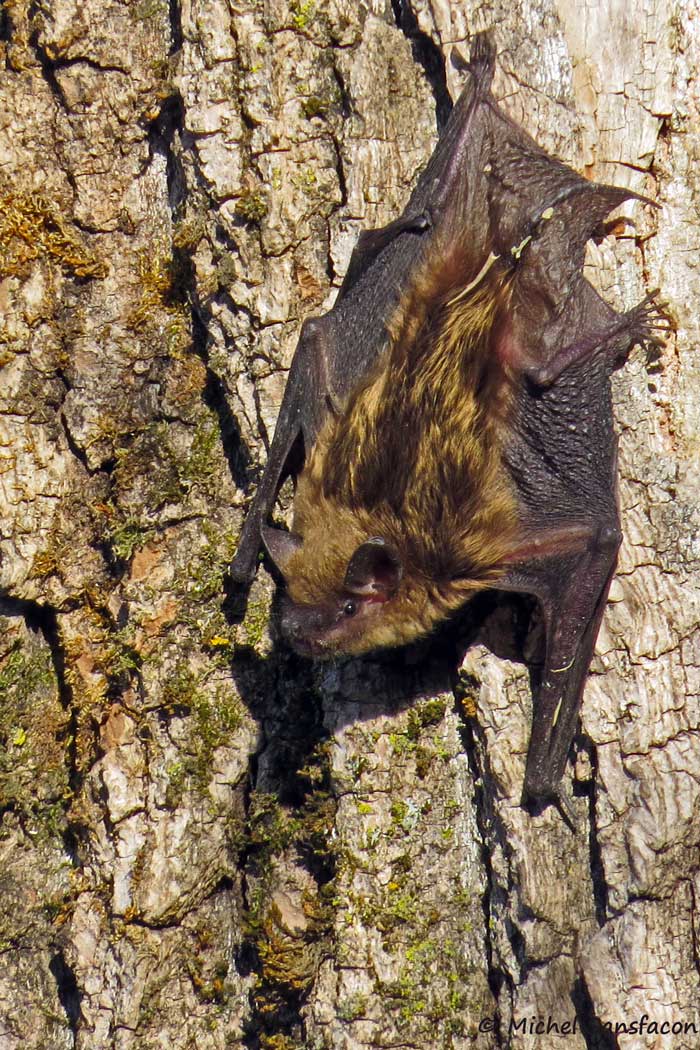TAKING A BAT INVENTORY

Bat colony validation protocol
In order to validate the presence of a bat colony, it is possible to rely on certain indicators such as noise (scratching sounds or vocalizations) and feces (which is called guano and is similar to mouse feces, but longer and more slender and segmented).
However, the best way to confirm the presence of bats is to observe their emergence at dusk. To do this, the first step is to locate their entry and exit points. These are often found where walls meet the roof, in dormers, or above window frames. The following is the best method for spotting these openings.
- Openings can be identified by examining the site during the day. They are often indicated by the presence of excrement on the walls.
- If the entrances are hard to locate (which is often the case), it can be useful to dedicate an evening to locating them before proceeding with the bat count. The best conditions for observing bats are warm evenings without wind or rain.
- On the evening of the observation, observers should ideally be placed at each corner of the building, each observing one side, so that the entire surface is monitored. Each participant should be equipped with a flashlight or a headlamp; however, these should never be pointed directly at the bats’ exit location.
- If there is an insufficient number of participants or if the building is too large or irregularly shaped, place people at angles around the building or spread them out so that the entire surface of the building can be monitored.
- Once an opening is identified, efforts can be concentrated on another part of the building. If you are alone, you will have to observe the entire building; therefore, the observation process will take longer. Proceed in a systematic way by observing one side or section at a time.
Protocol for counting bats
1. Performing a bat count is essential to assessing the size of the maternity colony. For best results, it is best to conduct counts on warm nights when it is not windy or raining.
2. Counts can be performed during two summer periods. The first is from mid-June to early July. This is called the pre-volant period, when the young bats have not yet begun to fly. The second period is from mid-July to early August. These dates may vary by location; in some regions, many of the young have left the maternity colony by early August. If you are only able to complete one count per year, ensure it is always done during the same period. To obtain the best possible assessment of the number of bats in a maternity colony, bat counts should be done on two nights, only a few days apart. It should be noted that bats do not leave at the same time every night. Also, a certain number of bats may opt to stay inside for various reasons (to remain with the young, for example). Performing two separate counts on two different evenings will provide a more accurate picture of the number of bats in the colony. However, even if you can only perform one count, that data is still valuable! Please note that the count should be recorded even if no bats are observed. This information is useful for monitoring bat populations.
3. Before beginning your count, complete Section A of the form (see below). Next, transcribe your results in the online form at batwatch.ca
4. Once on site, find the previously identified openings. At sunset, place two people at each opening. Bats generally begin to emerge about 30 minutes after sunset, but 45 or even 60 minutes may pass before they appear, so it is important to be patient. Both observers are responsible for counting all the bats that emerge from their assigned opening. If more than one opening is used by the bats, place one observer at each opening and make a note of this in the “Comments” section of the form.
5. For better viewing, observers should be placed slightly diagonally, 10 to 15 metres from the opening. Shine a flashlight a little to the side of or below the opening so as not to disturb the bats.
Very bright, direct light may prevent the bats from emerging. It is important to remain very attentive and keep your eyes on the opening so as to see every bat that emerges. Depending on the location of the opening, it may be difficult to observe every bat that comes out.
6. Count all the bats that emerge through your assigned opening. It is important to avoid counting bats that are simply flying around near the opening of the maternity colony, since they may be from a different site.
7. If a few bats (2 or 3) return to the roost while others continue to emerge, continue the count. Should it become too difficult to follow the comings and goings of the bats, or should too many bats re-enter the opening, stop the count and take note of the time.
8. If no bats return to the roost, stop the count approximately 30 minutes after the last bat has emerged.If possible, take note of the time at which the last bat emerged. Write down the time and temperature at the end of the count.
9. Write down the results of the count. Note the name of each observer and the number of bats counted by each. If bats emerged through more than one opening, make a note of this. Assign a number to each opening and indicate which observer was assigned to it. Add up the counts from each opening to obtain the total number of bats. If more than one observer was placed at each opening, mark down the number counted by each observer. The count for that opening will be the average of all the counts.
Next, transcribe your results in the online form: https://batwatch.ca/participer/ajout_colonie
10. You may discover new openings during the count. It is important that these be noted on the form and, if necessary, identified on a diagram.
11. You can attach a diagram or photos of the openings and/or of the maternity colony.
Warning: If you touch a bat
An injury from a bat can go unnoticed, which is why any person who touched or was touched by a bat must:
Immediately wash exposed skin with soap and water for 15 minutes.
Contact their provincial health line where a specialist will determine if a rabies vaccine is required: Quebec: Info-Santé at 8-1-1
If possible, safely trap the bat
The Info-Santé agent will explain how to have the bat tested.
If your pet comes into contact with a bat
contact your veterinarian.
IN SUMMER (APRIL TO OCTOBER)
Confine the bat to a single room by closing the door(s) to the room.
Open the windows, remove the screens and turn off the lights in the room.
Leave the room, closing the door behind you. In most cases, the bat will detect the draft of fresh air and leave the house on its own. If it does not leave, wait for it to settle down and capture it using the protocol described below, then keep it contained in a box. If no one (human or pet) has come into contact with the bat, release it outside, ensuring that no person or animal is able to touch it.
If possible, place the box at the base of a tree, open it carefully and move away. Wait 24 hours, then check to see if the bat is still in the box. It is important to wait at least 24 hours because bats are able to lower their body temperatures and enter a state called torpor, where the bat may appear to be dead even if it is alive. After 24 hours, if the bat is still in the box and has not moved, refer to the section entitled “If you find an injured, dying or dead bat” and contact the appropriate agency (see below).


IN WINTER (NOVEMBER TO MARCH)
If you find an active bat during the winter, it is because it has woken up from hibernation. It requires a lot of energy for a bat to awaken from hibernation; therefore, it will be in a very fragile state. The instructions for capturing a bat (provided below) must be followed. It is abnormal for bats to fly around in the daytime in the middle of winter. This is a potential sign that the bat is infected with white-nose syndrome (WNS).
If a bat is found in the winter or is found injured, dying or dead, please follow the instructions below.
In Canada, any bat that is found in the winter or that is found ill or dead must be reported to the appropriate organization:
Quebec residents: Ministère des Forêts, de la Faune et des Parcs (MFFP) at 1-877-346-6763
How to safely capture a bat
1. If you must move or handle a bat, wear thick gloves.
2. You will need a container (e.g. a yogurt container) and a sheet of rigid cardboard. Cover the bat with the container and slide the cardboard across the mouth of the container in order to close it off.
3. Ensure that air can get into the container, and place the container in a box.
4. Place the box in a dark, quiet area.
5. Disinfect your gloves. Once you have removed your gloves, wash your hands thoroughly with soap and water.
6. Depending on the circumstances, see the instructions below to determine whom you should contact.
Preventing bats from entering your home
1. Try to find the opening(s) where the bats entered the house.
2. Apply caulking to the points of entry.
3. Ensure that your windows and doors are properly equipped with screens.
4. Cover exterior openings with a screen.
Sites used for maternity colonies are essential to the reproduction of bats. Although it is important to preserve them, cohabiting with bats can be difficult. Nevertheless, it is important not to disturb a maternity colony during the breeding period, as young bats that are unable to fly will become trapped inside and die. Their mothers will therefore use any means possible to reach their young. Colonies may be removed in April or May, before the pups are born, or between late September and October, when the colony disperses.
If it is absolutely necessary to remove a colony, you can do so yourself by following these steps:
Step one: Observation
This can be done during the summer. To remove a colony from a building, you must locate the openings to the colony and block them. The most frequently used openings can sometimes be identified by the blackish stains that surround them. Observe the building at dusk to find the location(s) from which the bats emerge.
Step two: Blocking the openings
In October, when the bats have begun their migration, you can start blocking the openings with silicone sealant, steel wool, mortar, a screen, etc. While completing this task, it is important to block all openings used by the bats as well as any other openings measuring 2 cm or more. Leave one or two holes open to ensure that any remaining bats can escape.
Step three: Eviction
Install a screen or polypropylene bird netting in front of the remaining openings. Using staples or small nails, attach the top and sides of the screen/netting to the building. Allow the remaining lower part to hang in front of the opening. Do not attach the bottom. This will allow the remaining bats to exit the building, but they will not be able to re-enter. At the end of October, the remaining openings can be closed off permanently. For more information, consult the following links:
http://www.batcon.org/resources/for-specific-issues/bats-in-buildings
Step four: Installing a bat house
Bats are very loyal to their roosting sites. It is certain that they will return the following spring and attempt to find a way inside, which is why it is important to block all openings. However, it is possible to offer the bats an alternative. Install bat houses as far off the ground as possible to protect the bats from predators. The ideal spot is close to the opening that was most frequently used by the bats. The number and size of bat houses will depend on the size of the colony, but installing several houses is recommended to maximize the chances of success.
The following signs may indicate the presence of bats in your home.
Noise
Various low-volume sounds, such as scratching or vocalizations, may be heard.
The presence of feces, known as GUANO
- It is segmented, long and crumbly.
- It becomes powdery when crushed or ground.
- If the colony is large, an unpleasant odour may develop.
- There may be feces on the walls where the bats enter and exit the home.
The presence of urine
- It crystallizes at room temperature.
- Surfaces where it has been deposited may appear powdery.
TIPS FOR LIVING TOGETHER
The belief that bats cause the same types of damage as some rodents is false. In fact, bats do nothing more than enter through a pre-existing opening in the building and occupy little-used spaces such as attics. The main inconvenience is the accumulation of feces. In order to avoid any unpleasantness due to the presence of feces, one option is to lay a plastic sheet on the ground where it accumulates. This should be done in early spring. The sheet can then easily be removed at the end of the summer once the bats have departed for their hibernaculum (e.g. a cave or abandoned mine), where they will spend the winter.
If a bat colony has taken up residence in your attic, it is important to caulk or seal off any openings between the attic and the living areas of your home. This precaution will reduce the risk of contamination.
If you believe that bats have taken up residence in your home, there is no reason to fret. The likelihood that any bat in the colony is infected with rabies is very low. Like most mammals, bats can contract rabies, but the incidence of rabies in bats is only one percent. However, it is still important to be careful around bats so as to avoid any chance of becoming infected, since rabies is fatal to all mammals, including humans. It should be noted that ill or dying bats that are found on the ground are more likely to be infected with rabies. For this reason, you should never touch a bat with your bare hands, even if it is dead.
Ideally, the attic or other area inhabited by bats should not be accessed while bats are present. In any case, the bats are not likely to be observable since they tend to hide themselves away in inaccessible areas. If you wish to see them, wait outside their exit location at nightfall. They will come out on their own.
FORM
SOURCES
Ministère des forêts, de la faune et des parcs. Juillet 2014. Protocole de validation d’une colonie de chauves-souris. 1p.
Chauves-souris aux abris. Avril 2017. Protocole pour un décompte de chauve-souris dans une maternité. 4p.
Chauves-souris aux abris. Vivre en harmonie avec une colonie de chauve-souris [en ligne]. http://chauve-souris.ca/vivre-en-harmonie-avec-une-colonie-de-chauve-souris
Chauves-souris aux abris. https://chauve-souris.ca/content/déloger-une-colonie
Chauves-souris aux abris. Quoi faire si vous trouvez une chauves-souris dans votre maison?
https://chauve-souris.ca/sortir-une-chauve-souris-de-la-maison [page consultée le 22 novembre 2017].
PHOTO CREDIT
Daniel Jauvin
Jocelyne Feizo
Michel Sansfaçon
Yves Déry




